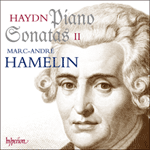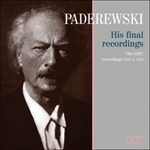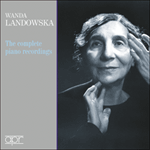Haydn composed the Sonata ‘Un piccolo divertimento’ (Variations in F minor), in Vienna in 1793 for the talented pianist Barbara (‘Babette’) von Ployer, for whom Mozart had written the concertos K449 and K453. This profoundly felt music vies with the Andante of the ‘Drumroll’ Symphony as Haydn’s greatest set of alternating minor–major variations. After the stoic melancholy of the F minor opening, with its gently insistent dotted rhythms, the ornate F major theme exudes a kind of whimsical, abstracted playfulness. Haydn originally ended with the second F major variation and a few bars of coda. He subsequently appended a reprise of the F minor theme and a long, disturbingly chromatic coda that draws unsuspected force from the pervasive dotted rhythms before dissolving in a feverish swirl of arpeggios. After a measure of equilibrium is restored, the dotted rhythms toll deep in the bass, like a funeral knell. Haydn was the least confessional of composers. But it is not far-fetched to suggest, as several commentators have done, that the tragic intensity of the coda may have been prompted by the sudden death of Maria Anna von Genzinger, at the age of forty-two, on 26 January 1793.
from notes by Richard Wigmore © 2009
Haydn composa la Sonate «Un piccolo divertimento» (Variations en fa mineur) à Vienne, en 1793, pour la talentueuse pianiste Barbara («Babette») von Ployer, à qui Mozart avait destiné ses concertos K449 et K453. Cette musique profondément sentie dispute à l’Andante de la Symphonie «Roulement de timbales» le titre de plus grand corpus de variations alternant mineur et majeur. Passé la stoïque mélancolie de l’ouverture en fa mineur, aux rythmes pointés doucement insistants, le thème orné en fa majeur exsude comme un enjouement étrange, absorbé. À l’origine, Haydn termina sur la deuxième variation en fa majeur, augmentée de quelques mesures de coda. Plus tard, il ajouta une reprise du thème en fa mineur et une longue coda au chromatisme dérangeant, qui tire une force insoupçonnée des envahissants rythmes pointés avant de se dissoudre en un fébrile tourbillon d’arpèges. Après le rétablissement d’une dose d’équilibre, les rythmes pointés sonnent dans les tréfonds de la basse, tel un glas. De tous les compositeurs, Haydn fut celui qui s’épancha le moins dans sa musique. Mais il n’est pas saugrenu de suggérer, avec plusieurs commentateurs, que l’intensité tragique de cette coda a pu être déclenchée par la mort soudaine de Maria Anna von Genzinger le 26 janvier 1793, à l’âge de quarante-deux ans.
extrait des notes rédigées par Richard Wigmore © 2009
Français: Hypérion
Haydn komponierte das Sonate „Un piccolo divertimento“ (Variationen in f-Moll) 1793 in Wien für die begabte Pianistin Barbara („Babette“) von Ployer, für die Mozart die Konzerte K449 und K453 geschrieben hatte. Diese tief empfundene Musik wetteifert mit dem Andante der Symphonie „mit dem Paukenwirbel“ um den Ehrenplatz als Haydns größte Variationen in abwechselndem Dur und Moll. Nach der stoischen Melancholie des f-Moll-Anfangs mit seinem sanft insistierenden punktierten Rhythmus bringt das zierreiche F-Dur-Thema eine Art launischer, abstrakter Verspieltheit mit sich. Haydn schloss das Werk ursprünglich mit der zweiten F-Dur-Variation und einer kurzen Coda ab. Später fügte er eine Reprise des f-Moll-Themas und eine lange, beunruhigend chromatische Coda hinzu, die unerwartete Kraft aus dem durchgängigen punktierten Rhythmus bezieht, bevor sie sich in fiebrig wirbelnde Arpeggien auflöst. Nachdem ein gewisses Maß von Gleichgewicht wieder hergestellt wird, tönt der punktierte Rhythmus wie eine Totenglocke tief im Bass. Haydn trug als Komponist selten sein Herz auf der Zunge. Aber es ist nicht weit hergeholt, wie mehrere Kommentatoren zu spekulieren, dass die tragische Intensivität der Coda durch den plötzlichen Tod von Maria Anna von Genzinger am 26. Januar 1793 im Alter von 42 Jahren angeregt wurde.
aus dem Begleittext von Richard Wigmore © 2009
Deutsch: Renate Wendel


 Handel & Haydn: Angela Hewitt plays Handel & Haydn
Handel & Haydn: Angela Hewitt plays Handel & Haydn Haydn: Piano Sonatas, Vol. 2
Haydn: Piano Sonatas, Vol. 2 Paderewski - His final recordings
Paderewski - His final recordings Wanda Landowska - The complete piano recordings
Wanda Landowska - The complete piano recordings
